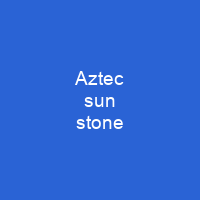The Aztec sun stone is a late post-classic Mexica sculpture housed in the National Anthropology Museum in Mexico City. The monolithic sculpture was buried in the Zócalo, the main square of Mexico City, after the Spanish conquest. It measures 358 centimetres in diameter and 98 centimetre thick, and weighs 24,590 kg.
About Aztec sun stone in brief

The stone was found half a yard under the ground surface and 60 meters to the east of the second door of the viceregal palace, and removed from the earth with a real rigging with double pulley. The parent rock from which it was extracted comes from the Xitle volcano, and could have been obtained from San Ángel or Xochimilco. The geologist Ezequiel Ordóñez in 1893 determined such an origin and ruled it as olivine basalt. It was probably dragged by thousands of people from a maximum of 22 kilometers to the center of Mexico-Tenochtitlan, and remained uncovered with the relief upwards for many. years. Towards the end of the 18th century, the viceroy Juan Vicente de Güemes initiated a series of urban reforms in the capital of New Spain. One of them was the construction of new streets and the improvement of parts of the city, through the introduction of drains and sidewalks. In the case of the so-called Plaza Mayor, sewers were built, the floor was leveled and areas were remodeled. According to Diego Durán, the emperor Axayácatl \”was also busy in carving the famous and large stone, very carved where the figures of the months and years, days 21 and weeks were sculpted””.
You want to know more about Aztec sun stone?
This page is based on the article Aztec sun stone published in Wikipedia (as of Dec. 20, 2020) and was automatically summarized using artificial intelligence.







